第七单元电子教案b
- 格式:doc
- 大小:136.00 KB
- 文档页数:19
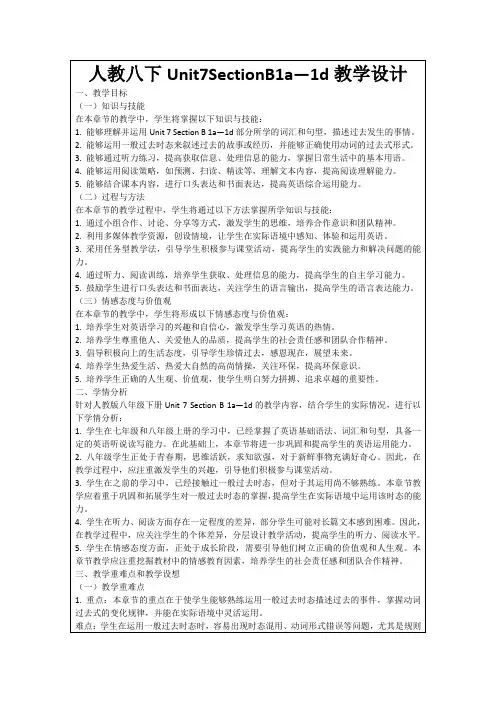

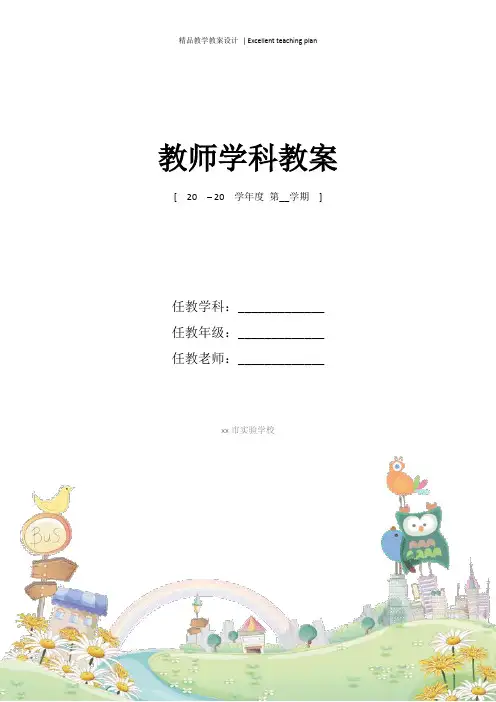
教师学科教案[ 20 – 20 学年度第__学期]任教学科:_____________任教年级:_____________任教老师:_____________xx市实验学校Unit 7 The Birthday PartyTOPIC 3 Everyone had a good timeSection B 教案Ⅰ. Aims and demands目标要求1. Learn some new words and phrases:fall, wash, at once, happen, stand up, come back, video game, everyone, truth, tell a lie, angry2. Talk about past events.I missed the chair and fell down.Did you hurt yourself?What time did you come home last night, Judy?3. Master the sentences about expressing blame and complaint.How could you lie to me?Why did you come back so late?Why didn’t you tell me the truth?Ⅱ. Teaching aids 教具图片/录音机/挂图Ⅲ. Five-finger Teaching Plan 五指教学方案Step 1 Review 第一步复习(时间:5分钟)复习生日聚会上的功能用语,导入1a。
(方案一: 此方案知识性强, 要求学生一定要熟悉上节课的内容。
)(用Section A, 1a复习康康生日晚会的情况, 引出康康生日的另一项活动。
)T: At Kangkang’s birthday party. What did his friends do?(教师手拿图片, 正面是人物, 背面是动词短语, 和学生一同回忆在康康的生日晚会上他们都做了哪些活动。
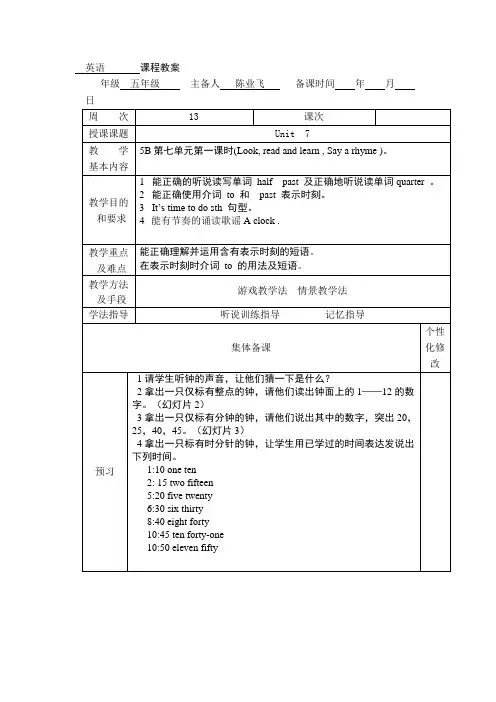
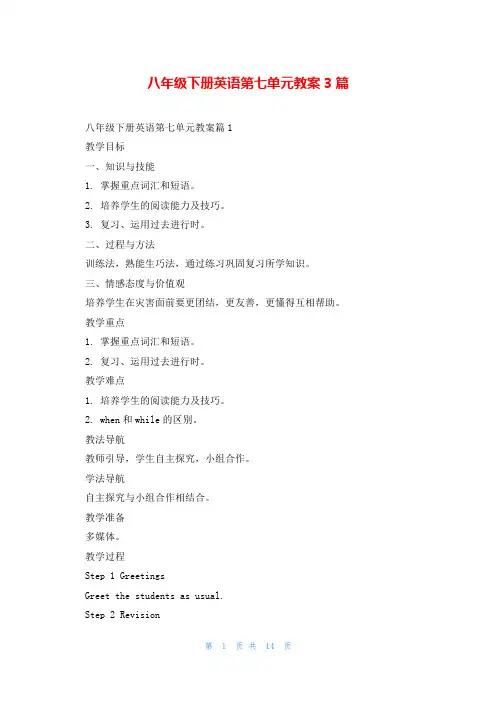
八年级下册英语第七单元教案3篇八年级下册英语第七单元教案篇1教学目标一、知识与技能1. 掌握重点词汇和短语。
2. 培养学生的阅读能力及技巧。
3. 复习、运用过去进行时。
二、过程与方法训练法,熟能生巧法,通过练习巩固复习所学知识。
三、情感态度与价值观培养学生在灾害面前要更团结,更友善,更懂得互相帮助。
教学重点1. 掌握重点词汇和短语。
2. 复习、运用过去进行时。
教学难点1. 培养学生的阅读能力及技巧。
2. when和while的区别。
教法导航教师引导,学生自主探究,小组合作。
学法导航自主探究与小组合作相结合。
教学准备多媒体。
教学过程Step 1 GreetingsGreet the students as usual.Step 2 RevisionAsk students to talk about what they were doing last night in groups of four then give a report.Step 3 PresentationAsk the students to look at the picture and think about what has happened.Step 4 Reading3a, Read the passage quickly and answer the following questions1. What was the weather like before the heavy rain started2. What was the neighborhood like after the stormAsk some students to report their answers.3b, Read the passage again and complete the sentences using information from the passage.1. When the news on TV was reported,strong winds _____________ outside.2. While Ben’s mom was making sure the radio was working,his dad _____________.3. Ben _____________________ when the heavy rain finally started.4. When Ben _______________at 3:00 a.m.,the wind_________________.Ask some students to report their answers.Step 5 Speaking3c, Discuss the questions with a partner.“Although the storm broke many things apart,it brought families and neighbors closer together.”What other can bring people closer together How can we help each other in times of difficultyAsk some students to report their answers.Step 6 Language points1. With no light outside,it felt like midnight.此句中介词with表示一种伴随状况,同时还包含着某种因果关系,表示“因某种状况的存在而导致…”,因此可翻译成“由于;因为”等。
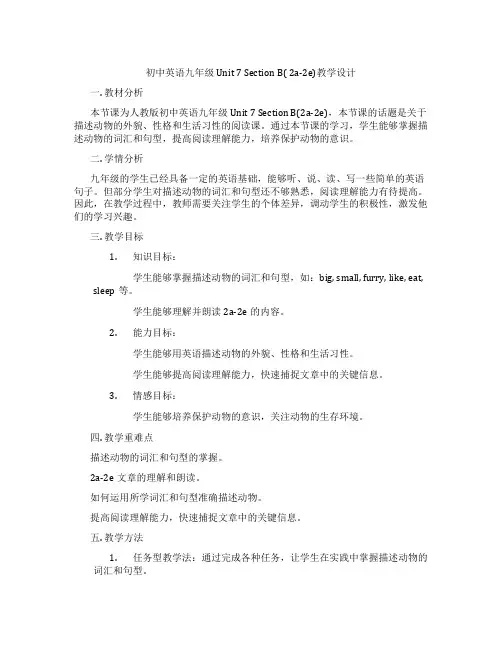
初中英语九年级 Unit 7 Section B( 2a-2e)教学设计一. 教材分析本节课为人教版初中英语九年级Unit 7 Section B(2a-2e),本节课的话题是关于描述动物的外貌、性格和生活习性的阅读课。
通过本节课的学习,学生能够掌握描述动物的词汇和句型,提高阅读理解能力,培养保护动物的意识。
二. 学情分析九年级的学生已经具备一定的英语基础,能够听、说、读、写一些简单的英语句子。
但部分学生对描述动物的词汇和句型还不够熟悉,阅读理解能力有待提高。
因此,在教学过程中,教师需要关注学生的个体差异,调动学生的积极性,激发他们的学习兴趣。
三. 教学目标1.知识目标:学生能够掌握描述动物的词汇和句型,如:big, small, furry, like, eat, sleep等。
学生能够理解并朗读2a-2e的内容。
2.能力目标:学生能够用英语描述动物的外貌、性格和生活习性。
学生能够提高阅读理解能力,快速捕捉文章中的关键信息。
3.情感目标:学生能够培养保护动物的意识,关注动物的生存环境。
四. 教学重难点描述动物的词汇和句型的掌握。
2a-2e文章的理解和朗读。
如何运用所学词汇和句型准确描述动物。
提高阅读理解能力,快速捕捉文章中的关键信息。
五. 教学方法1.任务型教学法:通过完成各种任务,让学生在实践中掌握描述动物的词汇和句型。
2.合作学习法:分组讨论,培养学生团队合作精神,提高阅读理解能力。
3.情境教学法:创设情境,让学生在真实的环境中运用所学知识。
六. 教学准备1.教学材料:教材、多媒体课件、动物图片、视频等。
2.教学设备:投影仪、计算机、音响等。
七. 教学过程1.导入(5分钟)教师通过展示一些动物的图片,引导学生谈论他们最喜欢的动物,激发学生的学习兴趣。
2.呈现(10分钟)教师播放2a的听力材料,让学生听懂并理解文章内容。
然后,让学生阅读2a-2e的文章,回答相关问题。
3.操练(15分钟)教师将学生分成小组,每组选一只动物,用所学词汇和句型描述动物的外貌、性格和生活习性。
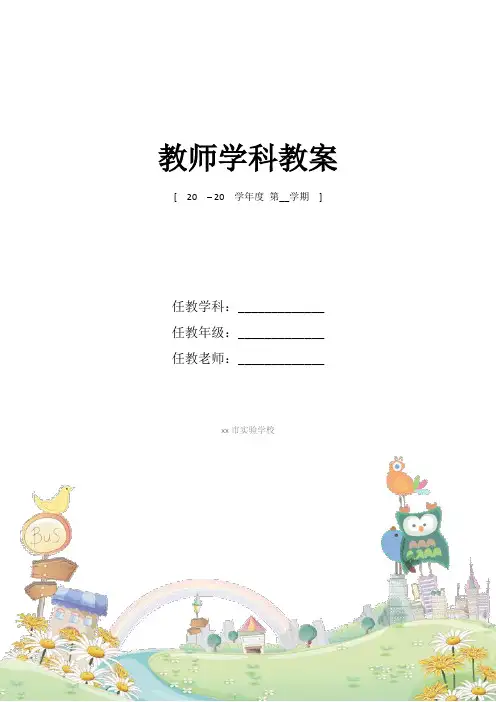
教师学科教案[ 20 – 20 学年度第__学期]任教学科:_____________任教年级:_____________任教老师:_____________xx市实验学校(最新版)Unit7 SectionB(2a-2e)精品教案Learning Goals:一、功能:使用“will + v. (动词原形)”谈论对未来的预测,描述自己想象中的未来蓝图。
二、词汇和常用表达:Learn and use the expressions:1.human, dangerous, already, factory, believe, disagree, even, shape, fall(fell), inside, possible, impossible, side, servant, over and over again, hundreds of, look for, fall down,2.*Fewer people will do such jobs in the future because they are boring, but robots will never get bored.*It will be difficult to make them really think like a man.*Some scientists believe that there will be more robots in the future.三、学习策略:阅读策略1.依据文章题目和所给图片,预测文章内容。
2.通过略读(skimming)的方式,猜测文章大意。
3.借助关键词,通过寻读(scanning)的方式,判断每一段段落大意,加深对篇章结构的把握。
四、情感态度:通过讨论机器人的现在和未来,激发、培养学生们对未来的想象力,并鼓励学生们为实现美好的梦想更加努力的学习。
Teaching and learning steps:Step I.Pre-reading activities1. PreviewAsk the Ss to turn to Page 53 and translate the following phrases into English. First ask the Ss to put them into English orally, then let them write English down without looking at the textbooks.(1)像人类一样思考______________________________________(2)人类服务员______________________________________(3)帮助做家务______________________________________(4)帮忙制造汽车______________________________________(5)变得厌烦______________________________________(6)使机器人看起来像人类______________________________________(7)不同意某人______________________________________(8) 多次,反复地_____________________________________(9) 花费数百年______________________________________(10)有许多不同的形状______________________________________(11)突然倒下;跌倒______________________________________(12)寻找建筑物底下的人______________________________________(13)似乎不可能______________________________________(14)做简单的工作______________________________________ Ask the Ss to turn to Page 53 and translate the following sentences into Chinese. (1) It will be difficult to make them really think like a man._____________________________________________________________________ _________(2) Some scientists believe that there will be more robots in the future._____________________________________________________________________ __________(设计说明:本部分词组和句子为学生的预习作业,词组和句子都是本节课的重要语言知识,该部分预习内容可以帮助学生更有目的性的预习。
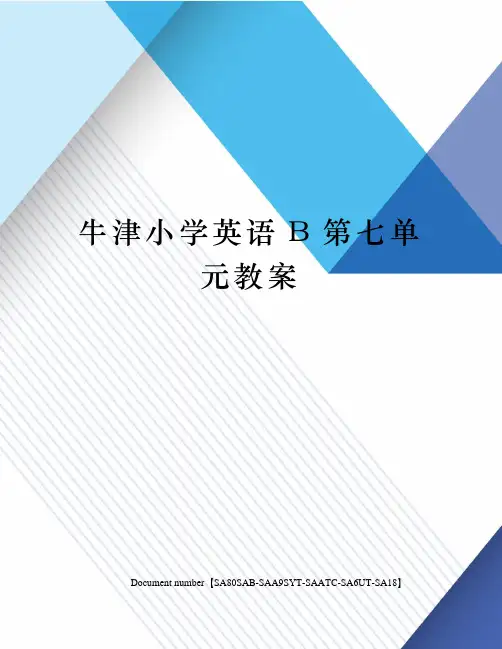
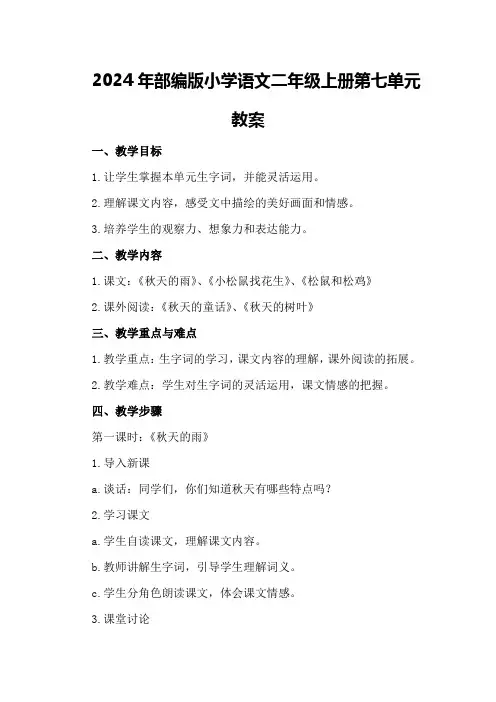
2024年部编版小学语文二年级上册第七单元教案一、教学目标1.让学生掌握本单元生字词,并能灵活运用。
2.理解课文内容,感受文中描绘的美好画面和情感。
3.培养学生的观察力、想象力和表达能力。
二、教学内容1.课文:《秋天的雨》、《小松鼠找花生》、《松鼠和松鸡》2.课外阅读:《秋天的童话》、《秋天的树叶》三、教学重点与难点1.教学重点:生字词的学习,课文内容的理解,课外阅读的拓展。
2.教学难点:学生对生字词的灵活运用,课文情感的把握。
四、教学步骤第一课时:《秋天的雨》1.导入新课a.谈话:同学们,你们知道秋天有哪些特点吗?2.学习课文a.学生自读课文,理解课文内容。
b.教师讲解生字词,引导学生理解词义。
c.学生分角色朗读课文,体会课文情感。
3.课堂讨论a.教师提问:课文中的小动物们是如何感受秋天的?4.作业布置a.家庭作业:熟读课文,背诵课文中的生字词。
b.课外作业:观察秋天的变化,写一篇小作文。
第二课时:《小松鼠找花生》1.导入新课a.谈话:同学们,你们知道小松鼠吗?它有什么特点?2.学习课文a.学生自读课文,理解课文内容。
b.教师讲解生字词,引导学生理解词义。
c.学生分角色朗读课文,体会课文情感。
3.课堂讨论a.教师提问:小松鼠为什么找不到花生?4.作业布置a.家庭作业:熟读课文,背诵课文中的生字词。
b.课外作业:以“小松鼠找花生”为题,编写一个故事。
第三课时:《松鼠和松鸡》1.导入新课a.谈话:同学们,你们知道松鼠和松鸡吗?它们有什么特点?2.学习课文a.学生自读课文,理解课文内容。
b.教师讲解生字词,引导学生理解词义。
c.学生分角色朗读课文,体会课文情感。
3.课堂讨论a.教师提问:松鼠和松鸡为什么成了好朋友?4.作业布置a.家庭作业:熟读课文,背诵课文中的生字词。
b.课外作业:以“松鼠和松鸡”为题,编写一个故事。
第四课时:课外阅读1.导入新课a.谈话:同学们,你们喜欢阅读吗?阅读可以让我们了解更多的知识。
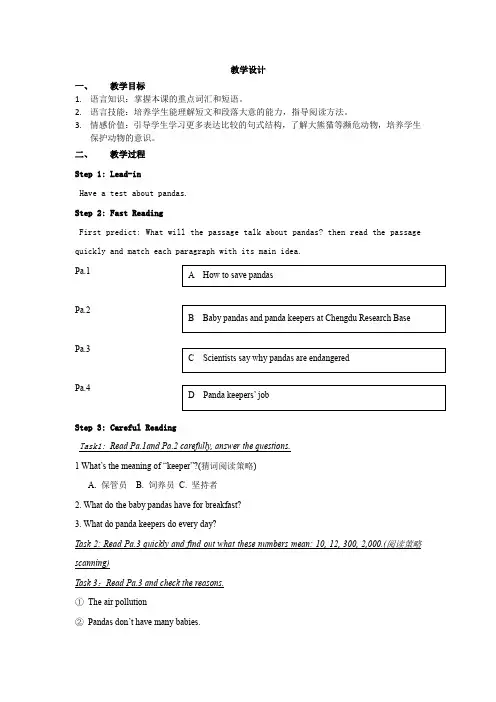
教学设计一、 教学目标1. 语言知识:掌握本课的重点词汇和短语。
2. 语言技能:培养学生能理解短文和段落大意的能力,指导阅读方法。
3. 情感价值:引导学生学习更多表达比较的句式结构,了解大熊猫等濒危动物,培养学生保护动物的意识。
二、 教学过程Step 1: Lead-inHave a test about pandas.Step 2: Fast ReadingFirst predict: What will the passage talk about pandas? then read the passage quickly and match each paragraph with its main idea.Pa.1Pa.2Pa.3Pa.4Step 3: Careful Reading Task1: Read Pa.1and Pa.2 carefully, answer the questions.1 What’s the meaning of “keeper”?(猜词阅读策略)A. 保管员B. 饲养员C. 坚持者2. What do the baby pandas have for breakfast?3. What do panda keepers do every day?Task 2: Read Pa.3 quickly and find out what these numbers mean: 10, 12, 300, 2,000.(阅读策略scanning)Task 3:Read Pa.3 and check the reasons.① The air pollution② Pandas don’t have many babies.③The hunters kill them.④Humans cut down the forests.Task 4:Read Pa.4 and finish the mind map.Step 4: Post Reading1 According to the mind-map, retell the passage.2 Group work: Please design a poster about how to save animals.Step 5:Summury教师利用图片总结本课内容并升华主题。
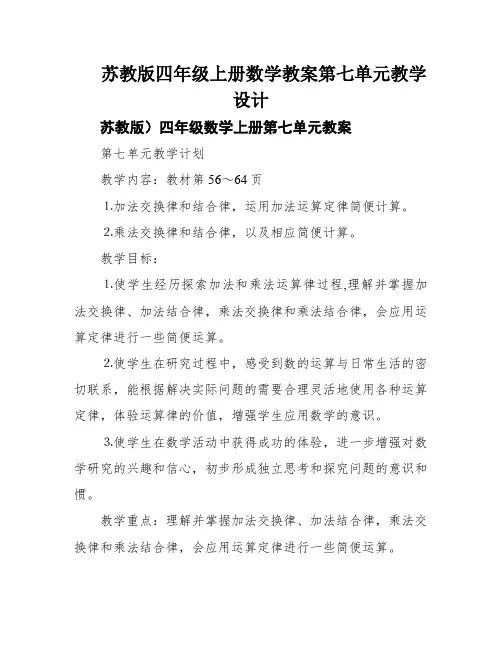
苏教版四年级上册数学教案第七单元教学设计苏教版)四年级数学上册第七单元教案第七单元教学计划教学内容:教材第56~64页⒈加法交换律和结合律,运用加法运算定律简便计算。
⒉乘法交换律和结合律,以及相应简便计算。
教学目标:⒈使学生经历探索加法和乘法运算律过程,理解并掌握加法交换律、加法结合律,乘法交换律和乘法结合律,会应用运算定律进行一些简便运算。
⒉使学生在研究过程中,感受到数的运算与日常生活的密切联系,能根据解决实际问题的需要合理灵活地使用各种运算定律,体验运算律的价值,增强学生应用数学的意识。
⒊使学生在数学活动中获得成功的体验,进一步增强对数学研究的兴趣和信心,初步形成独立思考和探究问题的意识和惯。
教学重点:理解并掌握加法交换律、加法结合律,乘法交换律和乘法结合律,会应用运算定律进行一些简便运算。
教学难点:使学生在数学活动中获得成功的体验,进一步增强对数学研究的兴趣和信心,初步形成独立思考和探究问题的意识和惯。
教时安排:共计7课时加法交换律和结合律1课时2课时1课时应用加法运算定律简便计较练七单元练运算律11课时乘法交换律、结合律以及相关简便计算2课时教学内容:课本第56~58页教学目标:⒈在教学中从学生熟悉的实际问题的解答引入,让学生通过观察比较和分析,找到实际问题的不同解法之间的共同特点,初步感受运算规律。
⒉使学生在合作与交流中对运算律的认识由感性逐步发展到理性、合理地建构知识。
教学重点:加法交换律和加法结合律的归纳、总结。
教学难点:让学生体验运算的揭法的过程。
教学准备:课件、多媒体教学过程:一、复⒈口算42+38.75+6.13+21⒉揭露课题通过前面的研究,我们加法的意义有了肯定的了解,今天花我们要进一步研究和掌握一些加法的规律性知识,为今后研究打好根蒂根基.3.课前谈话。
师:我们来玩个语言游戏好吗?老师说个词,你们把它倒过来说一遍,比如,我说“喜欢”你们就说“欢喜”,会说吗?好,现在开始:“你们”(生:们你)啊?什么意思?想“XXX”老师呀?那可不行。
教师学科教案[ 20 – 20 学年度第__学期]任教学科:_____________任教年级:_____________任教老师:_____________xx市实验学校Unit 7 The Birthday PartyTOPIC 2 Can you sing an English song?Section B 教案Ⅰ. Aims and demands目标要求1. Learn some new words:smart, count, climb, pig2. Go on learning the usage of“can”for ability and “can’t” for inability.(1) Can you sing an English song? Of course I can.(2)What can a monkey do? It can climb trees, but it can’t swim at all.(3)He can speak English very well, but he can’t sing English songs.Ⅱ. Teaching aids 教具图片/面具/录音机/实物Ⅲ. Five-finger Teaching Plan 五指教学方案Step 1 Review 第一步复习(时间:7分钟)复习情态动词can的用法并引入1a。
1. (让学生听并学唱I can sing it well这首歌,完成5。
要求学生边唱边做动作。
复习情态动词can的用法。
)T: Let’s listen to the song I can sing it well together. We must sing and act at the same time. Example:Can you swim? Yes, I can. (边唱边做游泳的动作。
)Can you fly? No, I can’t. (边唱边用双臂做飞翔的动作。
第七单元人民解放战争单元体例单元主题历史要素第七单元人民解放战争重庆谈判、全面内战、土地改革、三大战役、南京解放备课说明一、单元课标要求基于《义务教育历史课程标准(2022年版)》的阐述,本单元讲述的是人民解放战争的相关史事,学生将通过对本单元的学习,知道重庆谈判,理解中国共产党为争取和平民主作出的努力;了解全面内战的爆发、中共中央转战陕北和刘邓大军挺进大别山等史事;通过了解解放区的土地改革,辽沈、淮海、平津三大战役,中共七届二中全会,知道国民党反动统治的覆灭和人民解放战争迅速胜利的主要原因,以及中国共产党领导人民取得新民主主义革命胜利的意义。
二、单元教材分析抗日战争胜利后,人们普遍期待和平建设国家。
中国共产党为争取和平、民主,作出很大努力。
但是,国民党坚持独裁统治,于1946年发动了全面内战。
中国共产党领导解放区军民,先后粉碎国民党军的全面进攻和重点进攻,之后展开战略进攻,发起三大战役。
1949年4月,解放军占领南京,宣告了国民党反动统治的覆灭。
三、单元学情分析经过一年多的学习,八年级学生已经积累起一定的历史知识,学习方法也有了一定程度的积淀。
学生在日常生活中通过影视作品、书刊报纸、网络信息等资源渠道,已经对本单元内容有了一定程度的了解。
但是,本单元内容比较琐碎,因此教师在教学过程中要努力通过情境再现、问题引领、史实讲述和多样化资源的运用等方式,激发学生的求知欲,引导学生积极、主动地学习。
四、单元教学目标1.知道重庆谈判,理解中国共产党为争取和平民主所作出的努力。
2.根据内战爆发时国共力量的对比等相关史事,认识战争初期敌强我弱的形势,分析人民解放军粉碎国民党军的全面进攻和重点进攻的原因,感悟人民解放军英勇作战、不畏牺牲的精神。
3.通过有关土地改革的文件、图片及影音资料,加深学生对土地改革的主要内容和意义的理解。
4.理解人民解放战争的胜利是人民的胜利,认识到人民命运与国家命运交织,人民群众是历史的真正创造者,中国共产党代表的是中国最广大人民的根本利益。
本单元内容是万以内数的认识。
包括数数、读数、写数、数的组成、数位的含义、数位的顺序和大小比较、近似数以及整百、整千数的加减法。
教材的编排要让学生体会到,一方面,数的产生与发展都是生活实践的需要;另一方面,生活中许多实际问题的解决都与数有关,利用数可以进行简捷而丰富的信息交流。
教学中除了重视学生的基础教学之外,根据课程标准还应重视培养学生的求知欲、好奇心、自信心和正确的学习态度等,要从学生的长期发展着眼。
数的概念是学生学习数学的基础,学生已经学习了“20以内数的认识”“100以内数的认识”,也知道10个一是十,10个十是一百。
本单元的教学,将认数的范围扩展到万以内,因此在教学时,可放手由学生自主认知,提高学生多样性策略解决问题的意识,更要让学生自己总结归纳数数的方法和规律。
在这一阶段,学生将认识更大的数。
它不仅是大数计算的基础,还在日常生活中有着广泛的应用,必须要掌握。
1.让学生经历数数的过程,体验数的产生和作用。
能认、读、写万以内的数,知道这些数是由几个千、几个百、几个十和几个一组成的,能够用符号和词语描述万以内数的大小,能说出各个数位的名称,识别各个数位上数字的意义。
2.结合现实素材让学生感受大数的意义,认识近似数,并能结合实际进行估计。
会口算整百、整千数的加减法。
3.让学生进一步学习用具体的数描述生活中的事物,并与他人交流,培养学习数学的兴趣和自信心,逐步提高学生的数感错误!未找到引用源。
1.将学生的生活经验作为认数的基础。
本单元的教学必须体现数与生活的密切联系,强调从学生身边的事物认识数。
事实上,学生在生活中积累了许多万以内数的知识,这是学习本单元内容的重要资源和必备的基础。
2.组织丰富多彩的有意义的数学活动。
要组织多样的学习活动,如数一数、拨一拨、猜一猜、写一写、比一比、说一说等,使学生通过大量的感性认识形成数的表象,进一步体会数的意义。
让学生在轻松愉快的游戏和紧张有趣的活动中形成万以内数的概念,经历将具体问题数学化的过程,激发学生强烈的求知欲,提高学生的数学素养。
Unit 7 would you mind turning down the music ?Section B辛店街道中学成爱萍Teaching aims1. learn the new words:complain about ,annoying, store clerk ,waitress, terrible, haircut, wrong size, be late, movie wait in line, happen, get mad, get annoyed, polite, all the time, long telephone , conversation, follow around, stand in the door, cut in line, return2. make requests and apologize:Would you mind doing sth ? Not at all. / Of course not.Would you mind not doing sth ? I’m sorry .I’ll do it r ight away.3.Important points :A: Would you mind doing sth ?B: I’m sorry .I’ll do it right away .A: Would you mind not doing sth ?B: Sorry. We’ll go and play in the park .4.Difficult points :比较: Would you mind (not) doing sth ?Could you please do sth ?Please do sth .You have to do sth .Teaching steps:Step 1. 1a:1.Read the instruction and ask Ss to read each situation and think about the two questions .2.Ask some students to share their answers with the class .Ask other students whether they agree with the opinions or not .Step2 1b .1. Help the students understand that something that is unpleasant or something that bothers you is annoying .2. Then ask the students to number the ideas from most annoying to least annoying .3. Ask the class to vote on the most annoying item on the list .Step3 2a .1. Read the instructions .Play the recording .This time Ss only listen .Answer any questions they have about the recording .2. Play the recording again and ask the students to write the number 1, 2 and 3 in front of the correct pictures .3. Correct the answers .Step 4 2b .1. Listen to the three conversations again .This time write the situations ,problems and solutions in the chart .2. Point out the sample answers .Play the recording again .Ask Ss to fill in the answers on their own .You may need to pause the tape from time to time to allow students to write answers in their books.3.Check the answers .Step5 2c .1. Read the instructions .Point out the problems in activity 2b .2. Ask some students to practice the conversations to the class .Step6 Reading 3a.1. let the Ss read the article first . Ask Ss which words they don’t understand. Write these words on the board .2. Ask students to underline the things that are annoying .Then have the students circle what people do when something annoying happen.3. Correct the answers with the class .Step7 , 3b .1. Look at each picture with the class .Ask different students to tell what is happening in each picture .2. Read the instructions and ask students to complete the activity on their own .3. Check the answers .Sstep8 4 groupwork .1. This activity provides speaking ,listening and writing practice using the target language .2. Ask students to complete the work in groups .Step 7 Self CheckSB Page 57, Part 1 .a. Ask Ss to fill in the blanks on their own .Check the answers.SB Page 57, Part 2 .a. Ask the students what might be annoying in the picture .b. Ask the students to write the letter on their own .c. Ask a few students to share their letters .Part 3 readingSB Page 58 , Section 1 .a. Read the title .Ask the students to predict what they think the article is about based on the article .b. Look at the picture .Ask students to describe what is happening in the picture .SB Page 58 , Section 2 .a. Encourage Ss to use the reading strategy of scanning for specific information .b. Ask Ss to read the article carefully once time .Then ask Ss to raise their hands and say which words and sentences they don’t understand .Encourage Ss to read in contest ,guessing the meaning of words and phrases from the other words around them.c.Ask the Ss to read the article again for comprehension .SB Page 58 , Section 3 .a. Complete the task .Ss can work individually or in pairs .b. Check the answers .c. Practice students’ speaking and listening skills .Step 8 sum upStep 9 Homework汉译英1. 你介意打扫一下教室吗?2. 你能否不在课堂上说话?3. 你介意把音乐声关小点吗?当然不会。
教师学科教案[ 20 – 20 学年度第__学期]任教学科:_____________任教年级:_____________任教老师:_____________xx市实验学校Unit 7 Part B教学目标◆语言知识目标1.学习单词:email,merry。
2.学习句型:Do you like...? Yes,I/we do.初步运用句子:It’s from....3.学说韵律诗:Jingle Bells.4.功能:询问他人喜好,节日祝福,描述圣诞节习俗。
◆语言技能目标1.能写简单节日贺卡,如:Merry Christmas!等。
2.能用句型Do you like...? 询问他人的喜好。
◆情感态度关注他人的喜好与感受,培养学生良好的交际习惯。
教具准备1.单词图片和卡片:email,merry。
2.各种小礼物。
3.一本日历、一张圣诞贺卡、一顶圣诞帽和一个小铃铛。
4.录音机和教学光盘。
教学步骤Step 1 Warming up1.师生互致问候。
2.齐唱歌曲:A Merry Christmas!3.揭示并板书课题:Unit 7 Christmas Part B4.教学单词merry。
(1)教师出示一本日历,指着12月25日,说:“Christmas is coming. Let’s say Merry Christmas to our friends!”板书:Merry Christmas!(2)出示merry单词卡片教学,告诉学生:merry和happy是同义词,但是,“圣诞快乐!”常说Merry Christmas!“新年快乐!”则说Happy New Year!再次强调:节日单词的首字母要大写,句子开头的第一个字母也要大写,句末要加标点符号。
(3)教师出示一张圣诞贺卡,教师示范写贺词Merry Christmas!请学生翻开课本第54页,完成Learn to write.练习。
Step 2 Revision1.复习词组a Christmas tree和a Christmas card。
第七组
教材分析
爱是明媚的阳光,给人以温暖;爱是盛开的鲜花,给人以芳香;爱是潺潺的溪流,滋润万物的成长;爱是熊熊的火炬,点燃生命的希望。
爱是理解,是宽容,还是力量。
有关爱的主题在前几册里已有所涉及,本册教材再次安排了“人间真情”的专题,是为了继续引导学生感受人与人之间纯真的感情,体会到人与人相互关爱,生命才更有意义,人生才更幸福。
教学目标
1.认识28个生字,会写37个生字,正确读写39个词语。
2.感悟诗歌的内容,想象诗歌所描绘的情景,体会朋友之间的深厚情谊,激起对祖国诗歌的热爱之情,培养课外主动积累诗歌的良好习惯。
3.正确、流利、有感情地朗读课文,感受乡亲们默默无闻、无私奉献的精神,并从中受到感染、熏陶,在朗读中体会李博士和台湾青年一心为他人着想的高尚品质,感受海峡两岸人民的血脉亲情,体会课文的思想感情。
4.体会“给予是快乐的”这句话的含义,激发助人为乐、无私奉献的思想感情。
教学重、难点
1.读懂课文内容,激发关爱他人、帮助他人的情感,读懂课文内容,从字里行间感受小男孩美好的心灵。
2.学习作者仔细观察、生动描写的方法,培养留心观察、用心感受的习惯。
3.看图作文,要求学生观察《胜似亲人》这幅图画,并根据画面内容展开想象,写一篇习作。
课时安排
11课时
教学建议
教学本组课文,应注意引导学生多读、多想、多体会,深切感受人与人之间纯真美好的感情,再由课文内容想开去,联系自己读过的和身边发生的感人故事,感悟互相关爱带来的快乐和幸福,使学生在情感上有所触动。
同时,应引导学生运用查字典或联系上下文的方法理解词语,通过体会重点语句感悟课文内容。